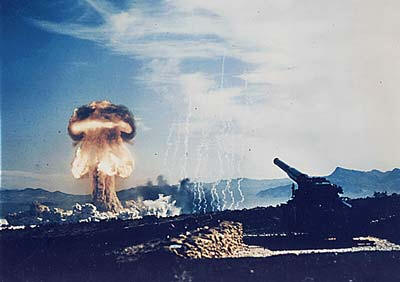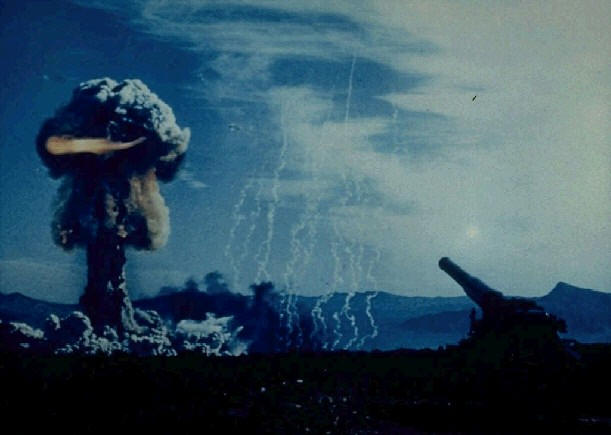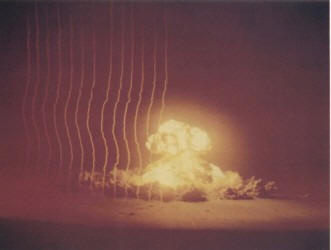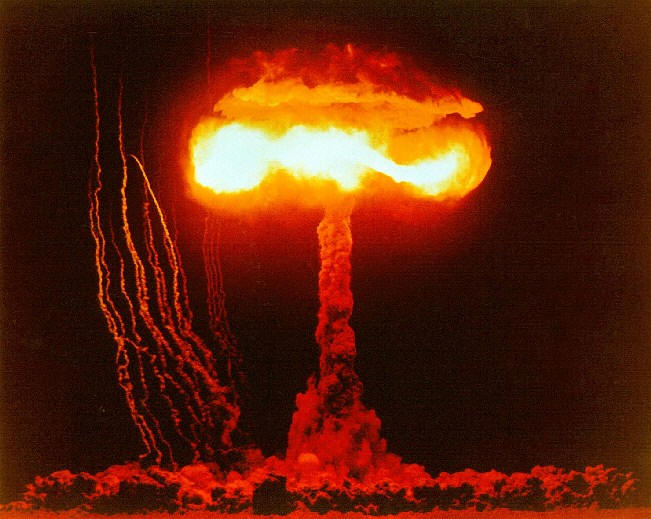The Atomic Gun!
 In 1953, the United States Department of Defense was conducting a series of nuclear weapons tests called Operation Upshot-Knothole.
In 1953, the United States Department of Defense was conducting a series of nuclear weapons tests called Operation Upshot-Knothole.
During this operation, eleven nuclear devices of varying yields were exploded at the Nevada Test Site, about sixty-five miles north of Las Vegas.
Among those atomic explosions was a test called Shot Grable, where the U.S. Army tried out its new toy, nicknamed "Atomic Annie."
Atomic Annie

Annie was a 280 millimeter portable artillery piece, able to fire her 800 pound shells a distance of about seven miles. But the thing that made her really special was the fact that her shells packed a nuclear payload with the equivalent destructive power of 15,000 metric tons of TNT.
This is the first test of a nuclear artillery shell (Grable for "gun") - the 280 mm AFAP (artillery fired atomic projectile). The shot was an artillery delivered airburst. The shell travelled 11,000 yards before detonation which occurred 86 feet west, 137 feet south, and 24 feet above the designated burst point.
The 280 mm shell was also a "gun" weapon in another sense, it used a "gun-type" fission weapon assembly method like the Little Boy bomb. This was in fact the first test of a gun-type bomb (and second detonation - Hiroshima not being a test). The predicted yield was 14 kt.
The Mk-9 280 mm (11.02 inch) shell was 54.4 inches long, weighed 803 lb, and used oralloy as the fissile material. Air burst detonation was arranged by a time fuze. The Mk-9 was fired by an enormous 85 ton artillery piece. The gun had a muzzle velocity of 2060 ft/sec, and a range of up to 20 miles.
Operation Upshot-Knothole
 By 1953 a pattern of test activity at the Nevada Proving Ground had emerged.
By 1953 a pattern of test activity at the Nevada Proving Ground had emerged.
Through the fifties, every year or (every other year if a pacific test series intervened) a series of several shots was fired at the NPG over a period of three or four months to address a wide variety of objectives.
Upshot-Knothole was just such a scatter-shot effort. Technical information to assist in weapon design was obtained in several tests. Efforts to prepare the U.S. military for atomic combat continued with proof-tests of a number of new tactical weapons, including the first nuclear artillery shell.
The tests provided additional experience and information for planning atomic combat operations. Important information was also obtained for civil defense efforts.
Boom!

And critically important - Upshot-Knothole also tested the radiation implosion systems for the world's first deployable thermonuclear weapons which would be proof-tested in Operation Castle the following year.
An estimated 18,000 DOD personnel participated in observer programs, tactical maneuvers, scientific studies, and support activities.
Members of all four armed services participated in Exercise Desert Rock V.